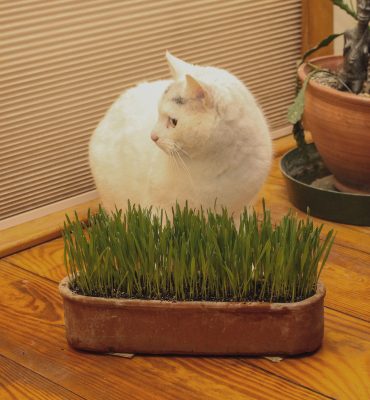Here Kitty, Kitty
To a Cat’s Delight
How does your cat like your houseplants? I don’t mean how they look. I mean for nibbling, a bad habit of some cats. Bad for them and bad for you because eating certain houseplants could sicken a cat, or worse, and, at the very least, leave the houseplant ragged.
One way to woo a feline away from houseplants would be to provide a better alternative. Now what could that be? Duh! Catnip, Nepeta cataria, a member of the mint family, admittedly not the prettiest of houseplants but, hey, you’re growing this for your cat, not yourself. (Other Nepeta species, such as N. x faasssennii and N. racemes, are less enticing to cats even if they are more attractive to us.)
Catnip is very easy to grow outdoors, and can be grown indoors through winter. The main ingredient that could be lacking in winter is light; six or more hours of sunlight beaming down on the plant through a window would be ideal. Other than that, needs are the same as most other plants: regular potting soil coupled with a watering regime that keeps said soil neither sodden nor bone dry, just moist.
Catnip plants are not hard to find. Growing from seed is easy, except the plants won’t be cat-ready for weeks and weeks.
Established plants are quick and easy to multiply so if you’ve got a friend with a potted plant, preferably overgrown so that you both benefit, you can make new plants by slicing the root ball into two or more new sections along with their above ground stems, and then repotting each of them. Or clip off stems each a few inches long, strip leaves from their bottom portions, and poke them into moist potting soil to root. Help these shocked plants or plant parts recover by keeping them in bright but indirect light for a couple of weeks — and protected from any cats!
Which brings me to perhaps the worst potential pest of your new catnip plant: cats! They’ll roll in it, releasing the strong aroma that drives them crazy, and nibble it to experience its narcotic effect. Outdoor plants tolerate such rambunctious playing; indoor plants, with less than perfect growing conditions, are more frail. You might want to limit playtimes to weekly visits.
Limiting playtimes might also keep the plant more enticing. Cats can habituate to catnip. And even then, only about fifty percent of cats fall under the spell of catnip, none of them as kittens.
—————————————
No reason to limit your cat’s botanical garden to catnip. Cats also like to nibble on grasses, which can be very pretty houseplants and lack the not very popular aroma (to most humans) of catnip.
It’s not clear why cats, which are carnivores, like that nibble. Perhaps, some say, to induce vomiting to get rid of undigested animal parts. Perhaps, others say, for vitamins and minerals.
“Grasses” is a term I use quite liberally, to mean not necessarily lawn grass but any plant in the grass family. Most convenient is to just mosey over to the local health food store and purchase some whole grain such as wheat (sold as “wheat berries) or rye. Soak a batch of these seeds in water for a few hours and then sow them in potting soil in a decorative container. Depending on the temperature, green sprouts should soon appear against the dark backdrop of soil. Grasses grow quickly, given light, warmth, and sufficient, but not too much, water.
The aforementioned grasses are annuals and at some point in their growth, what with cat nibbling and aging, will start looking ragged. Have another pot ready with already sprouting grass. And so on.
The grass serves well for us humans as well as our cats to enjoy. They’re very spring-like in their appearance even if confined to only a small pot, a microcosm of what’s to come.


I grew catnip in my garden once. After I cut it back, I threw the cuttings in my compost. After that I had lots of neighbor cats in my compost. Never did that again. I can’t grow catnip now because, as soon as it starts to grown, Bandit eats it to the ground. None of the other cats ever did that.
I had a cat years ago that was so fond of lemongrass (seed started-West Indian? with thinner stalks) I had to keep two big pots in rotation and let one regrow while the other was being nibbled to stubs. We used to joke it was because she was part Siamese. Now I have another cat with the same intense craving. The lemongrass is attractive when not chewed up, has a nice aroma in the house, and flourishes outside in summer. I wonder if anyone else has grown this and their found cats eating it? It appears to be safe for them.